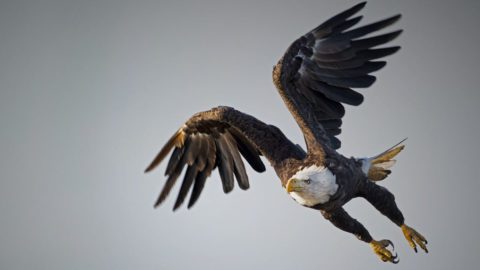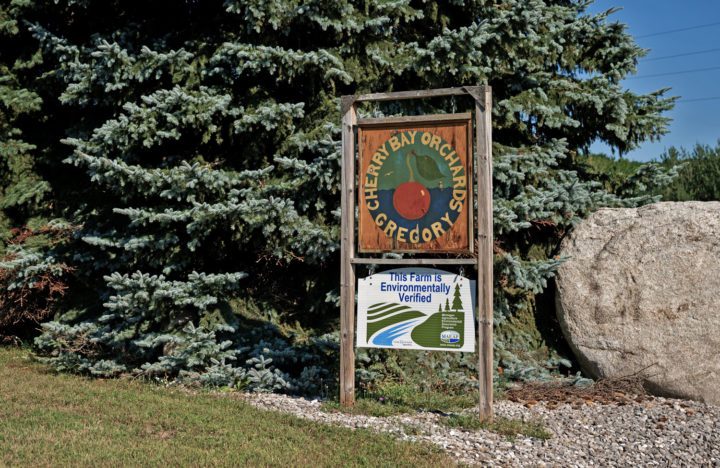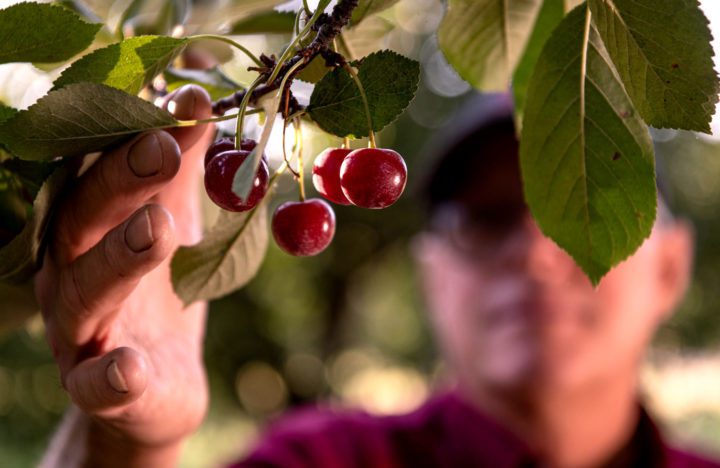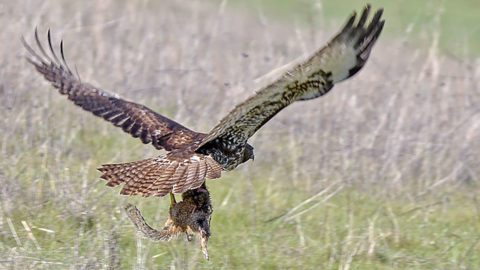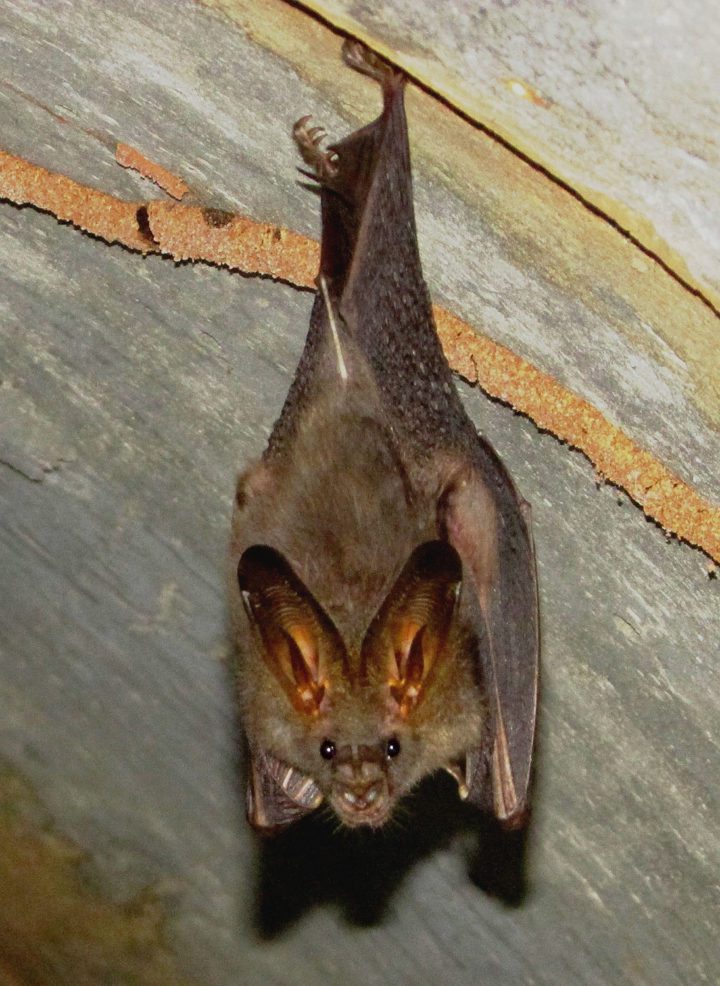At Orchards and Vineyards, Birds Are Outperforming Pesticides
By Greg Breining
Northern Parula by Ryan Sanderson/Macaulay Library. June 25, 2021Studies ranging from orchards in Michigan to vineyards in California and New Zealand show that birds including American Kestrels, Barn Owls, and Western Bluebirds are better than chemicals at reducing pest damage.
From the Summer 2021 issue of Living Bird magazine. Subscribe now.
Jim Nugent grows cherries on his 40-acre orchard in Michigan’s Leelanau County, an idyllic peninsula of dunes and tree-covered hills jutting into vast blue Lake Michigan. The surrounding water moderates the worst of the frigid winters here, and the rolling topography drains cold air from the upland orchards. Cherries thrive in the sandy soil.
“The fruit belt in Michigan is pretty tight to the coastline of Lake Michigan,” says Nugent. In that limited geography grow nearly half the U.S. production of tart cherries, and quite a few sweet cherries, too.
Despite ideal growing conditions, the cherry orchards here are beset by pests—a plethora of insects; deer mice and voles that gnaw the bark and roots of fruit trees; and flocks of fruit-eating birds that swoop into orchards, especially as sweet cherries ripen in early July.
“The damnedest thing you ever saw,” Nugent says of the birds. “They keep flapping their wings to stay in the tree. You get a cherry tree with six or eight seagulls on it and the limbs will be drooped down from their weight. It’s almost a comical sight.”
But not comical to the bottom line of a cherry grower, or any fruit farmer. A 2013 study showed that fruit crop damage from birds alone ranged from $104 per hectare in Oregon tart cherries to $7,267 per hectare in Washington Honeycrisp apples. Yield losses to rodents and birds in several high-value crops in California were estimated at 5% or greater.
So orchard owners are always on the lookout for better pest control. Thirty years ago, when Nugent worked for the Michigan State University Extension Service, he heard a professor of fisheries and wildlife recommend putting up nesting boxes to attract American Kestrels for controlling fruit-eating pests. Nugent built and set up his own kestrel box, which was occupied right away, and says he saw immediate results: “From the time I started getting nesting kestrels, I sure observed a decline in [pest] problems.”
Across America and beyond, farmers and vineyard and orchard owners are enlisting wild birds—from raptors to songbirds—in a sustainable battle against pests. They erect nest boxes, install raptor perches, or plant inviting native cover—all of which offer less expensive natural pest control than other traditional methods.
Birds are environmentally benign, while poisons are not. And pest-controlling birds stay on the job, while pesticides must be reapplied, and the effect of bird-scaring balloons, hawk silhouettes, and propane cannons quickly wears off.
Says Nugent, “All of that takes a lot more effort than if you can get a kestrel to nest next to the orchard.”
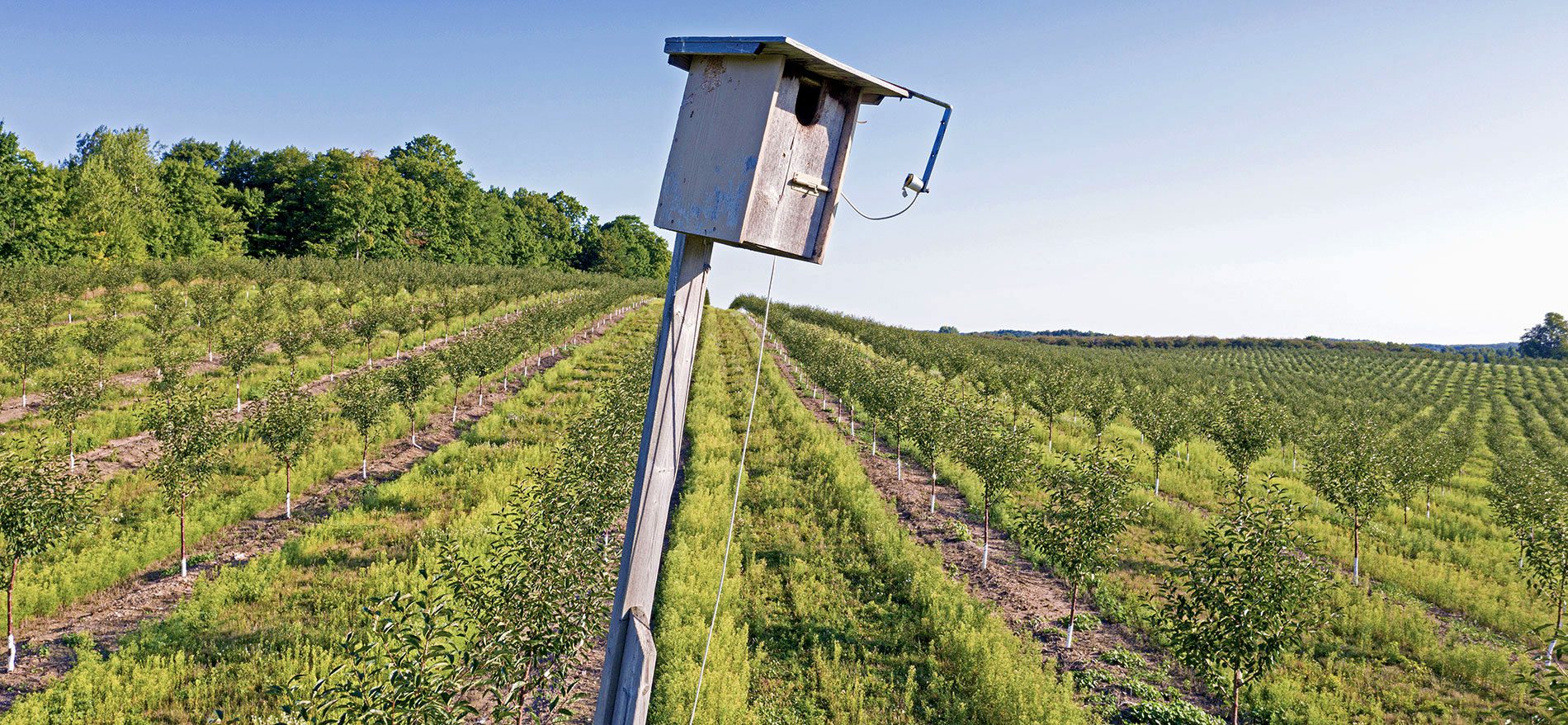
Cherries, Kestrels, and Agritourism
Cherry Bay Orchards—the largest cherry grower on the Leelanau Peninsula, with 1,200 acres of tart cherries, 300 acres of sweet cherries, and 275 acres of apples—has been dotted with kestrel boxes since the son of one of the workers began building them for an Eagle Scout project. Kestrels immediately took to the boxes.
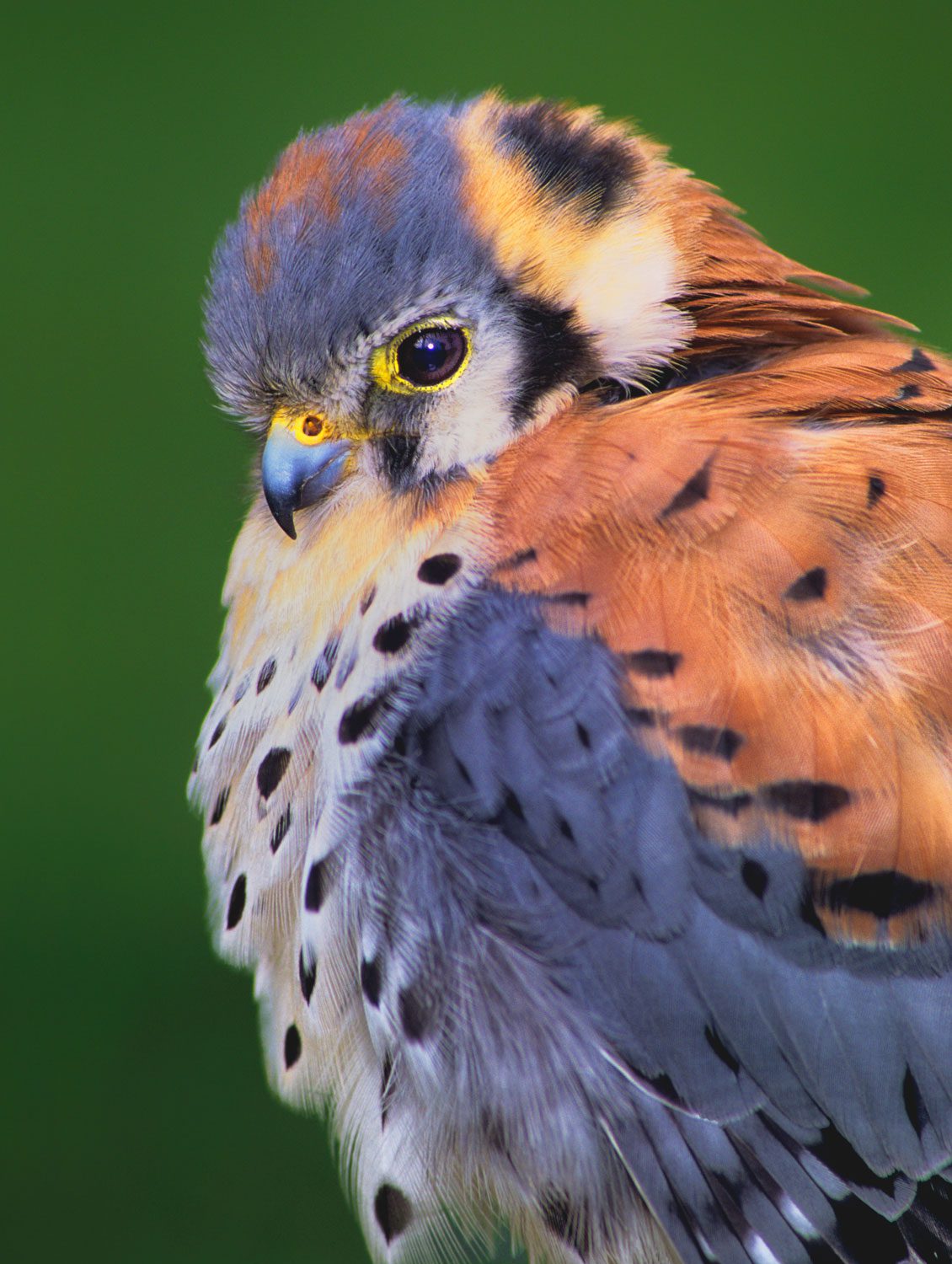
Forty years later, “we’ve probably got 75% to 80% occupancy right now,” says Francis Otto, orchard manager, who has worked for Cherry Bay for 34 years. “Especially when you’re putting the new orchards in, it really helps keeping the mice down.”
Otto loves seeing the migratory kestrels show up in April when they return to the orchard to nest: “They’ll be up on the wires with a mouse dangling from their talons, so you know they’re doing some good.”
Catherine Lindell, an associate professor of biology at Michigan State University, studied Cherry Bay and other orchards in the area between 2012 and 2016 and found that kestrels reduced the number of fruit-eating birds by killing some and scaring others away. Every dollar spent on nest boxes saved from $84 to $357 of sweet cherries from fruit-eating birds. Orchards with active kestrel boxes also had fewer mice and voles.
“It really is a low-cost thing that farmers can do to add to their integrated pest-management strategy,” says Lindell.
Farmers aren’t the only ones averse to pesticides. Research with Lindell’s Michigan State colleague Phil Howard showed consumers liked learning that raptors, rather than pesticides, had played a role in the growing of fruit.
“Consumers were really enthusiastic about [farmers] using kestrel boxes or falconry to manage pest birds, so we encouraged growers to let their customers know about that,” Lindell says. Attracting beneficial birds could also be a draw for “agritourists,” she says, which is allowing some growers to develop a birdwatching side to their business.

Leelanau orchard sign. Photo by Craig Watson. 
Cherries at the Leelanau orchard. Photo by Craig Watson.
And, Lindell found that orchard nest boxes are good for the kestrels. In Leelanau County, kestrel numbers seem to be increasing. She says the nest boxes in the area have a high rate of occupancy—good news for a species that has declined by more than 50% across the continent over the past 50 years.
But it turns out kestrels aren’t perfect for pest control everywhere. When Lindell moved her research farther south into Michigan’s blueberry region, starlings took over many of the nest boxes. Blueberries also ripen later in the summer, after kestrels have finished nesting and cleared out. And unfortunately, other local potentially beneficial raptors (such as Merlin or Cooper’s Hawk) don’t use nest boxes.
But in Michigan’s cherry country, orchard owners and kestrels are forging a mutually beneficial partnership.
“For the most part farmers are very enthusiastic because they’re interested in maintaining the environment, too,” says Lindell. “If it helps to reduce pesticide use, they like to do that. It costs them money to use pesticides.”
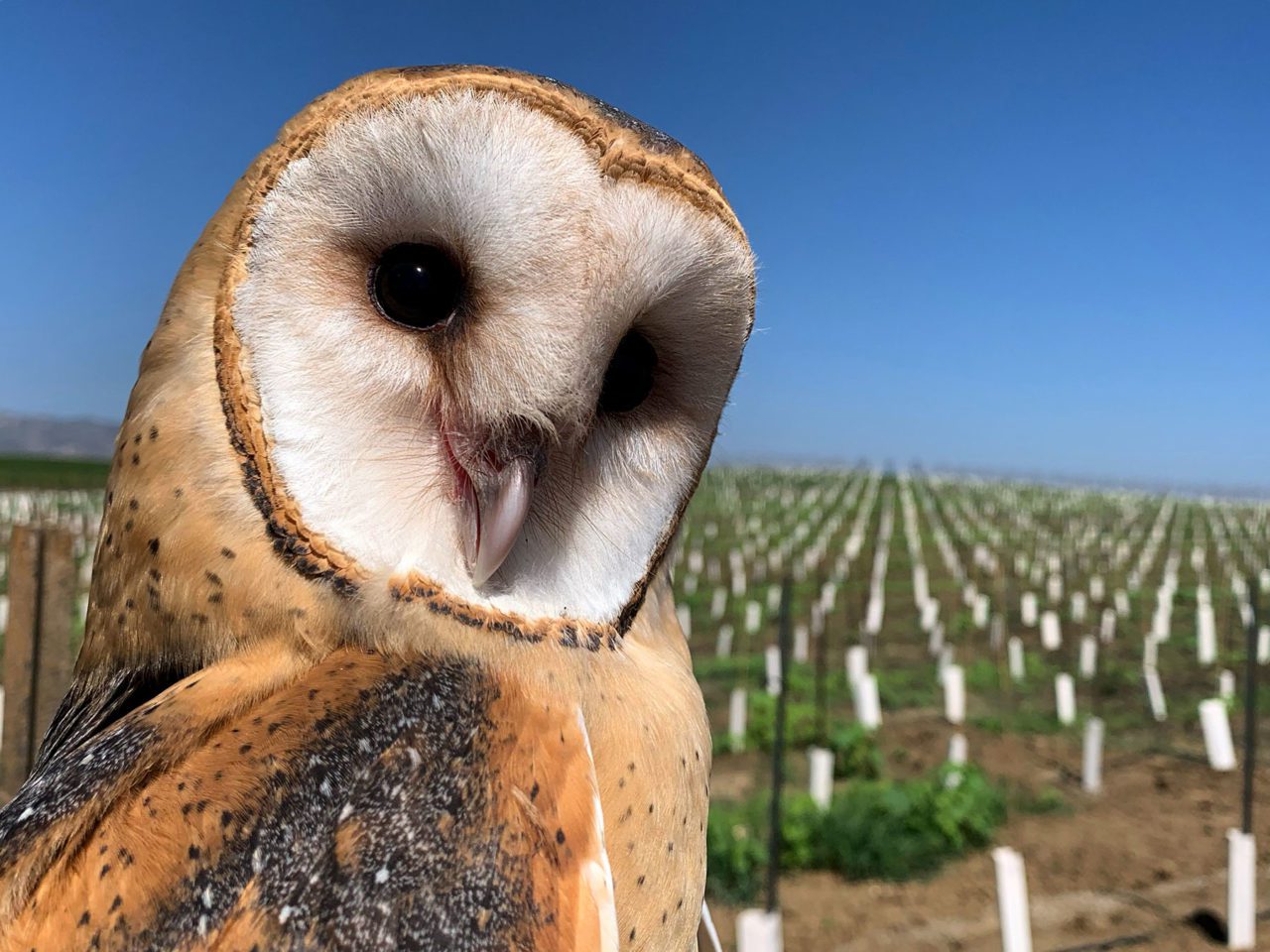
Owls and the “Gift Economy”
Barn Owls love nest boxes, too. And around the world, many farmers love Barn Owls as a way to control pests, says Matthew Johnson, professor in the Department of Wildlife at Humboldt State University in northern California.
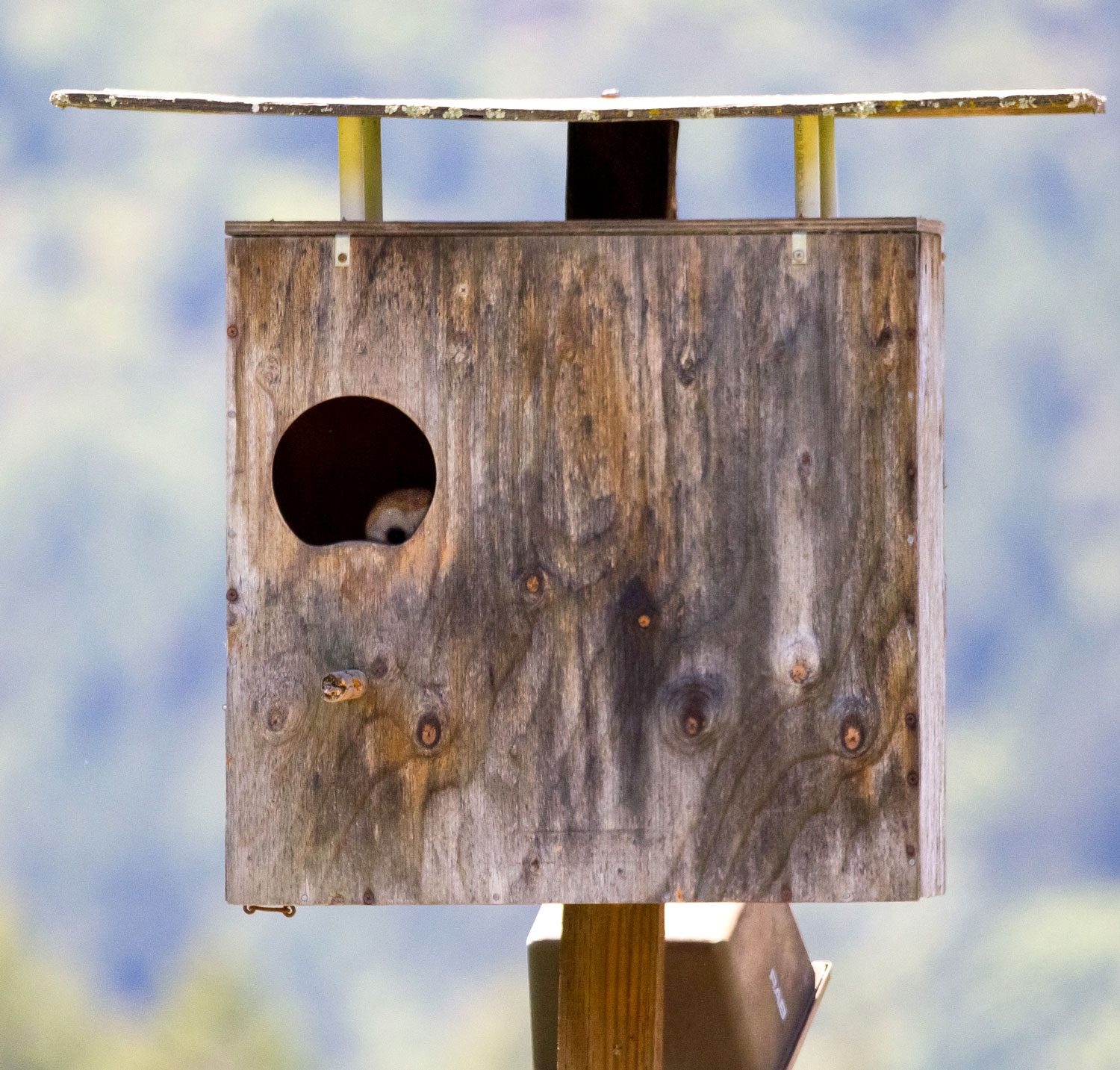
Johnson says farmers in South America and Africa, and palm growers in Malaysia, attract Barn Owls to control rats. Israel has a national program for installing Barn Owl nest boxes in farmlands. So Johnson’s interest in Barn Owls was piqued as he drove around California wine country.
“I kept seeing these Barn Owl nest boxes in vineyards and thought those have got to be up for more than just feeling good. The farmers have put those up in hopes of trying to control rodents,” he says. “But there hadn’t really been a lot in terms of scientific research on the topic.”
In 2015 he and his students began studying the value of Barn Owls in California vineyards, where pocket gophers and voles damage crops at the rate of $26 to $58 per acre. Their research, including video cameras mounted inside nest boxes, show that each chick in a brood consumes on average nearly 200 prey items—mostly gophers, voles, and mice—during the 10 weeks before it fledges from the nest box. Says Johnson, “We estimated 3,000 rodents killed over the course of the year by a single family of Barn Owls.”
Beyond documenting the prodigious appetites of Barn Owls, Johnson also found that the owls showed a strong preference for boxes placed near natural cover, such as grasslands and oak savanna. That begged another question: Are the owls nesting in the vineyards hunting amid the grape vines, or do they prefer eating rodents in the nearby wild areas? So they tagged some of the owls with GPS tracking devices, which revealed that even with native habitat nearby the owls spent a third of their time hunting in cultivated land.
More Ways Raptors Help the Landscape
Johnson’s advice to vineyard owners for maximizing the opportunities for getting Barn Owls in nest boxes: Leave some wild habitat near the areas where owl boxes are posted, which he says creates “an incentive for the farmers to conserve those uncultivated habitats—the riparian areas, the oak woodlands, and so on [that have] strong conservation benefits for all sorts of species, not just the Barn Owls.”
Says Johnson, “I’m interested in two sides of the same coin. How can farms be good for wildlife? And on the flip side, how can some of those birds or wildlife be good for the farmers?”
Ecologists tend to use the term “ecosystem services” to describe nature’s benefits to humans, but Johnson uses a different term.
“I think a better way to describe it is more like a gift economy,” he says. “This is something we’ve learned from indigenous cultures. That is, if people do things for wildlife, wildlife will do things for people.”
Wild Falcons Welcomed Back to Vineyards Down Under
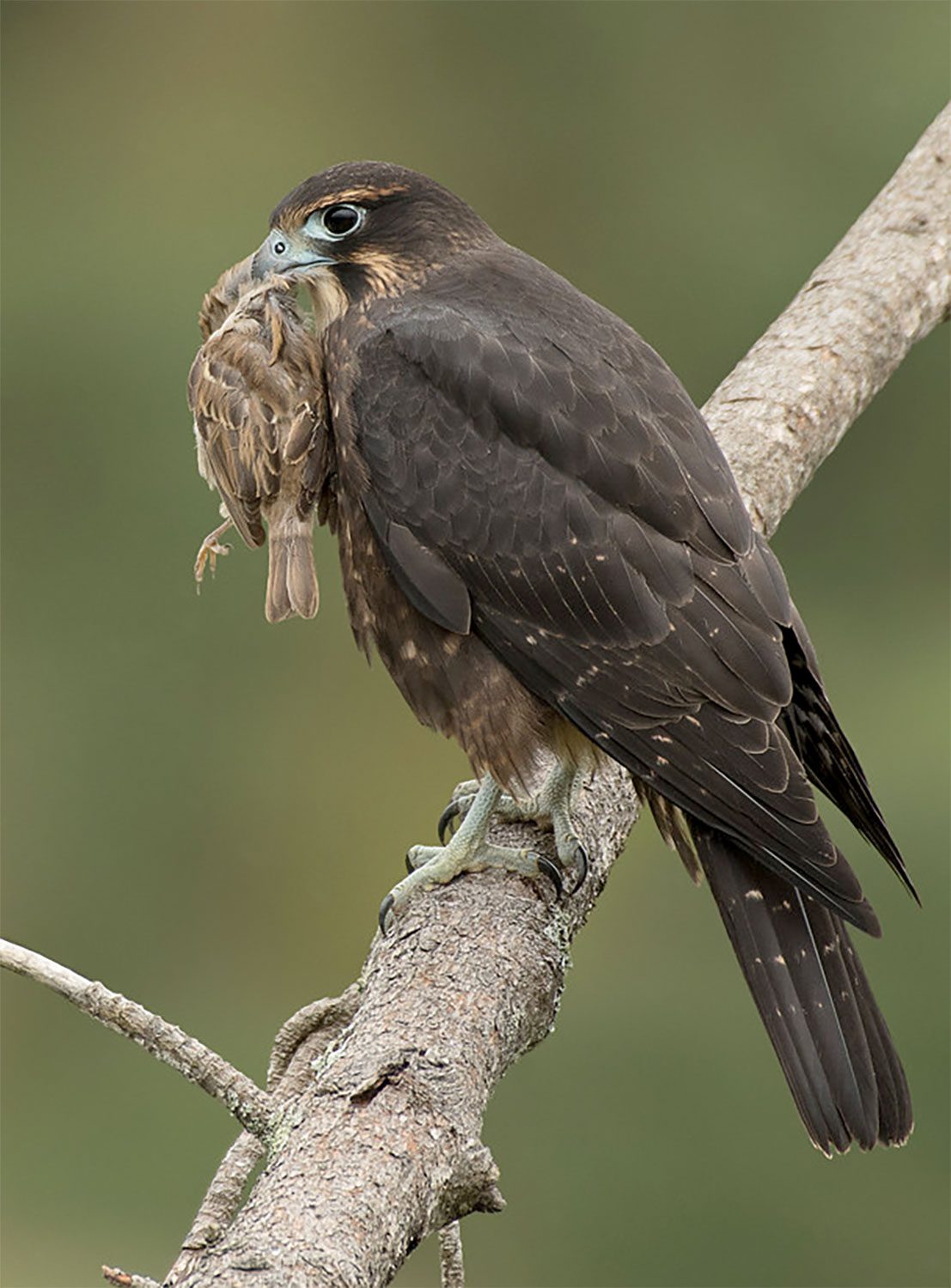
In New Zealand, the Marlborough Falcon Trust is reintroducing an endangered raptor while helping grape growers protect their crops.
The New Zealand Falcon—midsize between a Merlin and a peregrine—is brutally pugnacious, attacking people and even trucks and helicopters that approach too close to a nest.
“They will make contact with you every time if you’re near their nest and go round and round and round screeching at you,” says Sara Kross, who studied the birds in 2007 for her PhD. Now she’s director of the master’s program in the Department of Ecology, Evolution, and Environmental Biology at Columbia University in New York. But she still recalls her days wearing a padded leather Australian-style bush hat for head protection from the New Zealand Falcon.
“It definitely draws blood. I got whacked a lot,” she says, “as much as I would explain to them that I was just there to help them.”
So why would anyone want to help such a bird? It’s an iconic species, New Zealand’s only remaining endemic bird of prey, and it has fallen on hard times. Like other ground-nesting species on recently colonized islands, the falcon had no experience with the rats, cats, weasels, and other predators that tagged along with European settlers.
“That’s just a recipe for disaster for them as all these mammalian predators came into New Zealand,” says Kross. “They were sitting falcons is what they were.”
They were also being electrocuted by old-fashioned uninsulated transformer boxes on power lines. Once found from the mountains to the sea, the New Zealand Falcon persisted only in the high country.
Conservationists saw the opportunity for a twofer: introducing an endangered species to lowland habitat while helping to control an agricultural pest. Falcon reintroductions kicked off at the northern tip of the South Island in the Marlborough region, where sauvignon blanc and pinot noir grapes grow.
“It’s sort of the center of the wine industry there,” says Kross.
Initially four falcons were released to “hack boxes” that protected the nest from ground predators. Additional birds were released each year, and eventually the falcons began to breed. About a third survived and established territories. Another third died, often by electrocution. And some vanished, perhaps into the high country.
Kross began her research after the reintroduction was underway to determine how falcons were faring and how they fit into the vineyard landscape. Some growers were reluctant at first to host falcons, says Kross. But it turned out to be a good deal.
According to Kross’s research, published in Conservation Biology in 2012, the presence of falcons in a vineyard was associated with a 95% reduction in the number of grapes removed by birds and a 55% reduction in the number of grapes pecked. She estimated the falcons saved farmers up to US$326 per hectare ($132 per acre).
“The birds that are [raiding] the vineyards are almost all introduced species that have exploded in numbers,” she says. Reintroducing a predator as fierce as the New Zealand Falcon “changed the behavior of these birds that had become kind of gluttonous and brazen in their behavior in the vineyards,” she says. “It’s a concept in ecology called the ‘landscape of fear.’”
Falcons benefited as well. Compared with wild falcons in nearby uncultivated areas, the vineyard falcons ate more and raised more chicks.
The reintroduction has also paid some benefits to wine-country tourists. Winemaker Brancott Estate offers wine tastings with a flying demonstration by a captive falcon (not guarding a nest, thank goodness) and Q&A with a falcon handler.
Kross describes the reintroduction as a win-win—helping endangered falcons, helping beleaguered farmers.
“They put a lot of effort in trying to scare those birds away from their vineyards,” she says. “The falcons are essentially replicating that effort, and they’re being way more successful.”
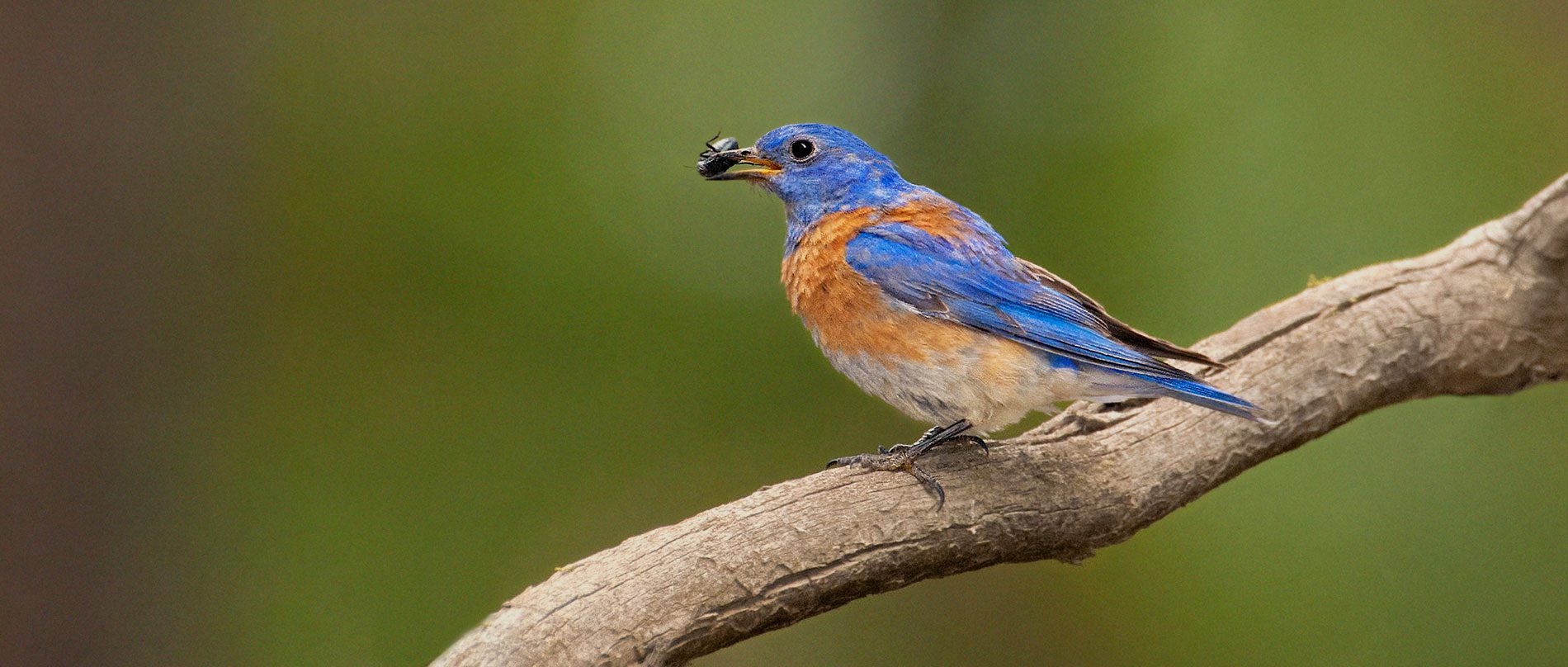
Natural Pest Control Has Wings
Raptors aren’t the only birds that help farmers. Also valuable are songbirds that patrol crops for insect pests.
Indonesian cacao plantations have documented increased yields of 290 pounds per acre of the valuable pods used in making chocolate—nearly $300 per acre—from having birds (and bats) in their fields. European apple growers have used nest boxes to attract Great Tits and reduce caterpillar damage by 50% compared to farms without nest boxes.
Birds are also known to eat the coffee berry borer, the world’s most damaging insect coffee pest. In Jamaica, Matt Johnson—the Humboldt State biology professor—has studied coffee plantations from the Blue Mountains in the east to Montego Bay in the west. He excluded birds from coffee bushes in certain areas of the plantation while allowing Black-throated Blue Warblers, Prairie Warblers, American Redstarts, Northern Parulas, and Black-and-white Warblers free rein in others. Then he compared borer damage in exclusion zones to damage elsewhere.
“They’re all eating this pest. Farmers can attract those types of birds to her or his farm by having shade trees that grow up above the coffee bushes,” he says.
The trees harbor other beneficial creatures as well, such as lizards, and sequester carbon to blunt climate change. By attracting birds, farmers save an estimated $126 per acre annually, according to Johnson’s research.
“The list of benefits from having more trees on farms is long,” he says.
In the United States, bluebirds play a big role in eating pests because they are so easily lured to a nesting box.
To estimate how many insect pests bluebirds and other insect-eating songbirds ate, Julie Jedlicka—an associate professor of biology at Missouri Western State University—set up an experiment with so-called sentinel prey. She immobilized live beet armyworms and placed them around California vineyards, some with bluebird nest boxes and some without. By recording the number of armyworms that the birds ate, she could estimate the effectiveness of bluebirds as predators of many kinds of insect larvae.
She discovered that nest boxes quadrupled the number of insectivorous birds; Western Bluebirds alone increased tenfold. In vineyards with nest boxes, the birds ate 2.4 times more of the sentinel prey than in areas without boxes.
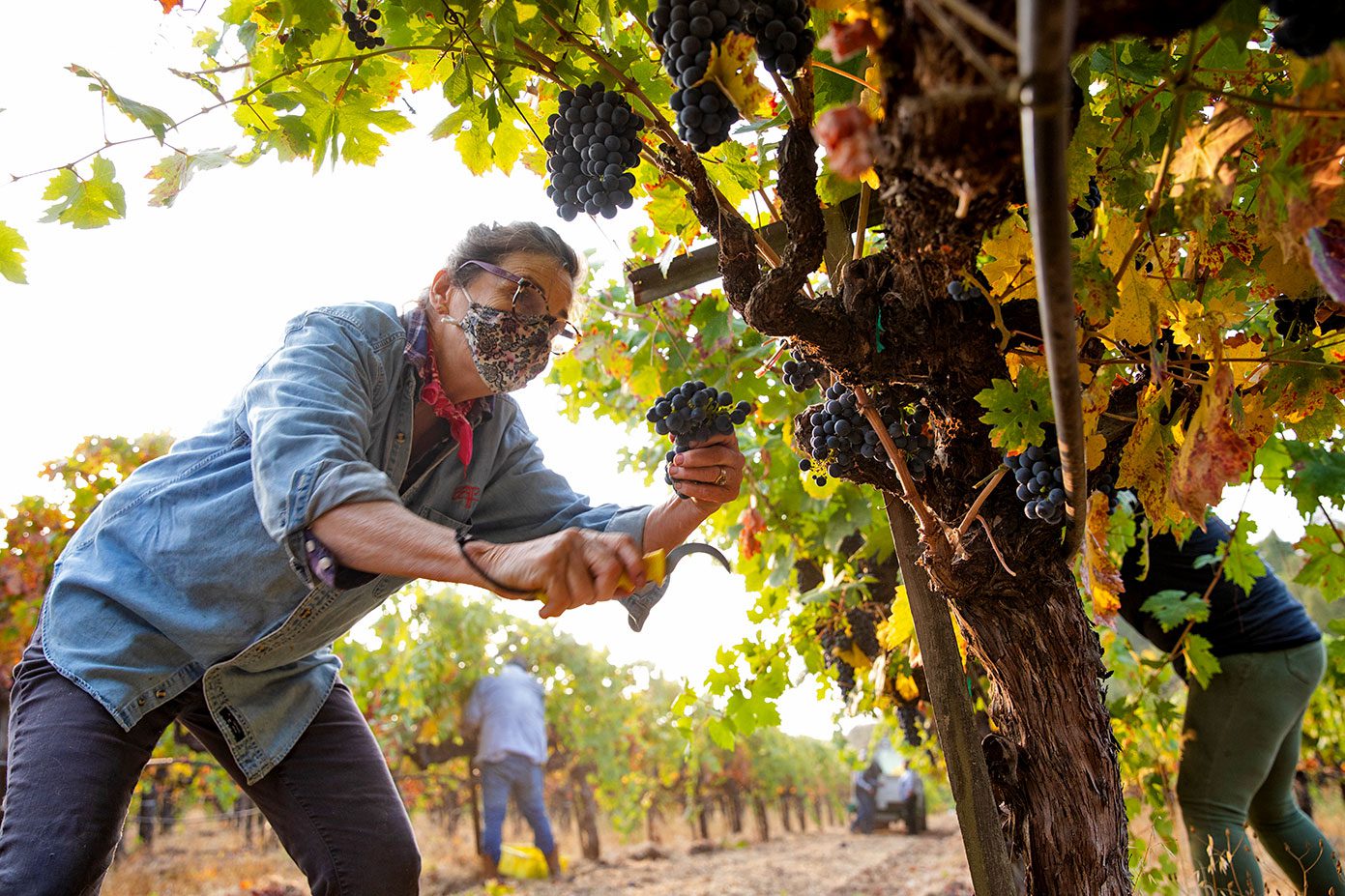
A similar sentinel prey experiment showed the value of birds in California walnut groves. The Central Valley produces 99% of walnuts exported from the United States, “so it’s a really big deal for that localized economy,” says Sacha Heath, now a biodiversity postdoctoral fellow at the Living Earth Collaborative.
Heath’s experiments with setting out codling moth larvae at orchards in the Sacramento Valley showed again that birds excel at pest control. Nuttall’s Woodpeckers and White-breasted Nuthatches flicked off flakes of bark to get at the moth cocoons. Sapsuckers, Bushtits, Bewick’s Wrens, and Northern Flickers also found the pupae. Birds ate four times as many larvae as spiders and insects. Notably, the songbirds were far more effective in orchards with a lot of natural habitat within 500 meters.
Julie Johnson has taken the importance of natural habitat to heart. Johnson owns Tres Sabores, an organic vineyard and winery in the Napa Valley. But she grows grapes on only a third of her 35 acres. The rest is covered in native and semi-natural cover—second-growth redwoods, bay, fir, pine, and various species of oak. A seasonal stream feeds a small pond.
Planted hedgerows contain native buckwheat, sages, rosemary, Mexican sunflowers, asters, cosmos, and other flowering plants. The hedgerows harbor many species of songbirds. About 150 pomegranate trees attract bees and hummingbirds.
Johnson has also set out 50 bluebird boxes, two Barn Owl nesting boxes, a kestrel box, and other shelters for swallows and even bats. In addition to the many bluebirds and other box-dwellers, her vineyard has a resident Red-tailed Hawk. She has documented at least three species of native owls on the vineyard.
“I’m trying to provide a very hospitable, welcoming environment,” she says.
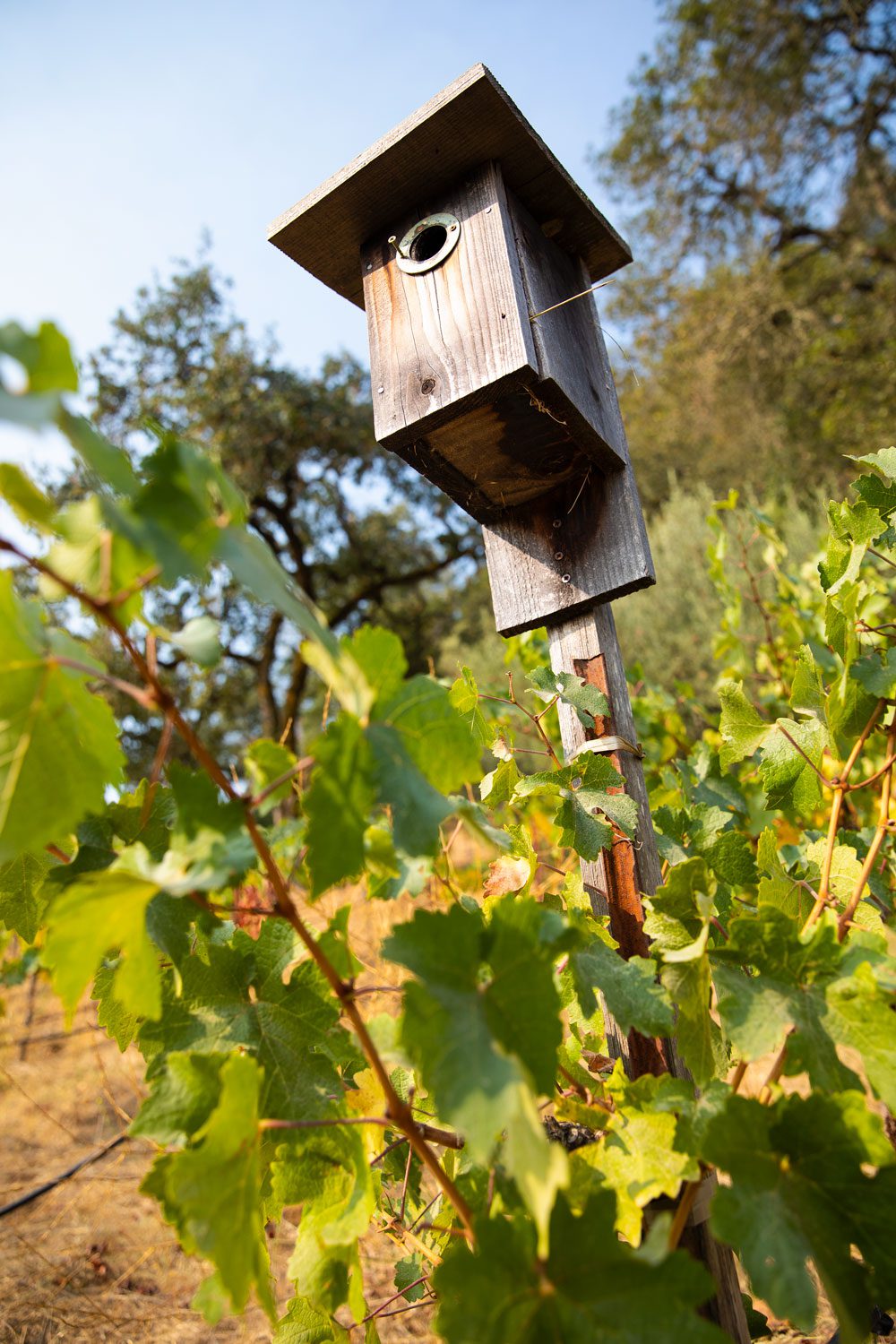
Rather than worry about which predators control which pests, Johnson simply put out the welcome mat with faith that the multitudes will work things out and prevent any one destructive species from taking over. By fostering diversity of plants and animals—especially birds—her vineyard is “self-regulated,” she says. “You’re not losing vines to Pierce’s disease. You’re not losing vines to other diseases because there’s diversity in the ecology of the farm.”
Johnson says her goal is “long-term resilience”—both of her vineyard and also of the surrounding natural environment.
“I can’t apologize for being in agriculture, but I can do the best that I can to emulate nature and to respect nature in what I do,” she says.
Johnson has encouraged research in her vineyard (by Humboldt State’s Matt Johnson, among others), and she is working with Wild Farm Alliance to promote the use of nest boxes and natural habitat on farms.
“Our mission is to promote healthy, viable agriculture that protects and restores wild nature,” says Jo Ann Baumgartner, executive director of Wild Farm Alliance. “Birds are just such a great example because of the benefits they provide.”
Baumgartner says the alliance has a vision of establishing a Songbird Farm Trail up the Pacific Coast: “Our goal is a million boxes from Baja to British Columbia.”
But nest boxes are only the first step. Restoring natural habitat, even just a few acres, to farms and other working landscapes is the best way to attract a range of beneficial species, says Baumgartner. While raptors and songbirds eat the pests, hummingbirds and bumblebees act as pollinators. At the same time, natural habitat sequesters carbon and soaks up runoff to keep groundwater, streams, and lakes cleaner.
“We really want to help growers understand how they can do more by putting in vegetative habitat,” she says.
It’s a plan for working with nature instead of against it that will benefit farmers and society as a whole—giving a gift, and getting a gift in return.
Freelance writer Greg Breining is a frequent contributor to Living Bird. He writes about wildlife, the environment, health, and science.

All About Birds
is a free resource
Available for everyone,
funded by donors like you
American Kestrel by Blair Dudeck / Macaulay Library
